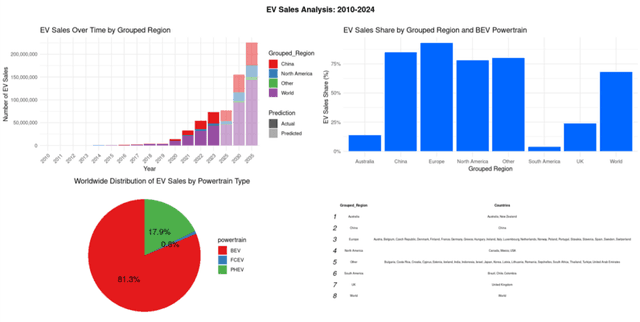Global EV Market Trends & Projections
E-commerce & Online Transactions
Tags and Keywords
Trusted By




"No reviews yet"
Free
About
This dataset offers a detailed overview of global Electric Vehicle (EV) sales and stock, spanning historical data from 2010 and projections extending to 2035. It delves into the evolution of various EV types, including Battery Electric Vehicles (BEVs), Fuel Cell Electric Vehicles (FCEVs), and Plug-in Hybrid Electric Vehicles (PHEVs). The data illustrates significant worldwide EV trends, highlighting the expansion of sales and the regional distribution of different powertrain types. It underscores the increasing adoption of EVs, driven by advancements in technology, environmental concerns, economic advantages, and governmental support. The dataset aims to provide insights into the transformative shift towards sustainable transportation and the enduring impact of electric mobility on the automotive industry.
Columns
- region: Indicates the geographic region or grouping for the sales data, such as World, China, or North America. This column contains 54 distinct values.
- Country: Specifies the individual country associated with the data point, also containing 54 distinct values.
- category: Classifies the data as 'Historical' (past sales) or 'Projection-APS' (future projections), among other categories. There are 3 distinct categories.
- parameter: Describes the metric being measured, such as 'EV stock' (total vehicles in operation) or 'EV sales' (new vehicles sold). This column has 8 unique parameters.
- mode: Differentiates between vehicle types, including 'Cars' and 'Buses', with 5 distinct modes.
- powertrain: Identifies the electric vehicle's power source, such as 'EV' (all electric vehicles), 'BEV' (Battery Electric Vehicle), 'PHEV' (Plug-in Hybrid Electric Vehicle), or 'FCEV' (Fuel Cell Electric Vehicle). There are 6 unique powertrain types.
- year: Represents the year for which the data is recorded, ranging from 2010 to 2035.
- unit: Defines the unit of measurement for the 'value' column, such as 'Vehicles' or 'percent'. There are 6 distinct units.
- value: The numerical data point corresponding to the region, category, parameter, mode, powertrain, year, and unit. Values range from 0 to 440 million.
Distribution
The dataset is available as a CSV data file named IEA Global EV Data 2024.csv. The file size is 874.99 kB. It is structured with 8 columns and contains approximately 12.7 thousand (12.7k) valid records. The data comprehensively covers various dimensions, including regional, temporal, and powertrain-specific information related to EV sales and stock.
Usage
This dataset is well-suited for a variety of applications and use cases, including:
- Market Research: Analysing historical EV sales trajectories and forecasting future market trends.
- Policy Analysis: Supporting the development and evaluation of government policies, incentives, and regulations aimed at promoting EV adoption.
- Strategic Planning: Informing business strategies for automotive manufacturers, energy providers, and charging infrastructure developers.
- Environmental Studies: Quantifying the impact of EV adoption on air quality and greenhouse gas emissions reduction efforts.
- Investment Decisions: Identifying opportunities and assessing risks within the rapidly evolving electric vehicle sector.
- Academic Research: Providing a robust foundation for studies on sustainable transportation, energy transition, and consumer behaviour in the automotive market.
Coverage
The dataset provides insights into global Electric Vehicle sales and stock.
- Geographic Scope: Data is included for various regions and countries across the world, with particular emphasis on leading markets such as China and North America.
- Time Range: The dataset spans historical records from 2010 up to 2024, and further includes projections extending to 2035.
- Vehicle Types: Information is segmented by different electric vehicle powertrains, including Battery Electric Vehicles (BEVs), Fuel Cell Electric Vehicles (FCEVs), and Plug-in Hybrid Electric Vehicles (PHEVs). Data is also categorised by vehicle modes like 'Cars' and 'Buses'.
License
Attribution 4.0 International (CC BY 4.0).
Who Can Use It
This dataset is ideal for:
- Automotive Industry Stakeholders: Professionals involved in vehicle manufacturing, sales, and aftermarket services.
- Government Agencies and Policymakers: Those responsible for developing and implementing transportation, energy, and environmental policies.
- Energy Sector Analysts: Experts focusing on grid infrastructure, renewable energy integration, and fuel demand forecasting.
- Urban Planners: Professionals designing future cities with sustainable and efficient transport systems.
- Financial Analysts and Investors: Individuals evaluating market opportunities and investment returns in the clean energy and automotive sectors.
- Researchers and Academics: Scholars and students undertaking studies in sustainability, engineering, economics, and public policy.
Dataset Name Suggestions
- Global EV Market Trends & Projections
- Electric Vehicle Sales Outlook 2010-2035
- Worldwide EV Adoption Data
- Future Mobility: Global EV Insights
- Electric Vehicle Powertrain Sales Analytics
Attributes
Original Data Source:Global EV Market Trends & Projections
Loading...
Free
Download Dataset in CSV Format
Recommended Datasets
Loading recommendations...
